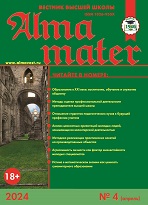https://doi.org/10.20339/AM.01-17.035
V.I. Teslenko is Dr.Sci. (Pedagogy), prof., head of sub-faculty e-mail: viteslenko@kspu.ru; and S.V. Latyntsev is Cand.Sci. (Pedagogy), doc., e-mail: serg-44117@mail.ru
at Krasnoyarsk State Pedagogical University n.a. V.P. Astfiev
Examined is the problem of formation and development of information literacy and training as to this activity of students of pedagogical high school with using in the named process of visual methods of education. Given is classification of illustrative visual material, using for aims of professional training of future teachers. Illustrative visual material is being analyzed in the context of using of visual educational means for formation of information literacy. Presented is the author’s approach to classification of illustrative material as to it’s role in formation of meta-meanings accordingly to groups of using methods of education. Also presented if methodic of construction of dynamic models of educational training tasks of various levels in the process of training student as future teacher to activity in forming informative literacy of his future trainees.
Key words: information literacy, communicative competence, classification of illustrative and evident material, system of communicative diverse-leveled tasks, dynamic models
References
- Zankov, L.V. Using of visual methods and making active students in educational process. Moscow, 1960.
- Leontiev, A.N. Activity. Consciousness. Personality. Moscow, 2005.
- Teslenko, V.I., Latyntsev, S.V. Communicative competence in the context of productive interaction. Krasnoyarsk, 2016.
- Teslenko, V.I., Latyntsev, S.V. Formation and development of communicative competence of students. Psychology of education, 2011, no. 7.











.png)






